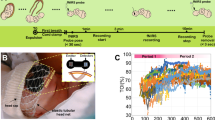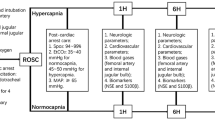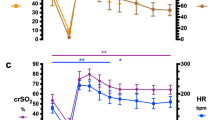Abstract
Previous studies have shown that severe neonatal asphyxia and hypoxia lead to a redistribution of cerebral blood flow (CBF) with a preferential perfusion of the brain stem.
The present study shows that this mechanism is operative also in moderately hypoxic newborn lambs (oxygen saturation 32.7–65.2) with a threshold of about 25% reduction in oxygen saturation. In hypoxia, the mean increase in total CBF, brain stem and telencephalic blood flow was 44%, 68% and 43%, respectively (five lambs).
We found that naloxone reverses this redistribution, and that the effects of naloxone on telencephalic perfusion and cerebral metabolic rate of oxygen (CMRO2) were proportional. In hypoxia + naloxone (1 mg/kg), a further increase in total CBF, brain stem, and telencephalic blood flow of 30%, 7% and 31% was noted.
We therefore suggest that the redistribution of CBF is an important opioid-mediated homeostatic mechaism, which diminishes the metabolic requirements of the newer part of the brain in hypoxia and allows a preferential perfusion of the vital structures of the brain stem.
Similar content being viewed by others
Abbreviations
- CBF:
-
cerebral blood flow
- CMRO2 :
-
cerebral metabolic rate of oxygen
References
Belik J, Wagerle LC, Delivora-Papadopoulos M (1984) Cerebral blood flow and metabolism following pancuronium bromide in newborn lambs. Pediatr Res 18:1305–1308
Carlsson C, Hägerdal M, Siersjö BK (1976) The effect of nitrous oxide on oxygen consumption and blood flow in the cerebral cortex of the rat. Acta Anaesthesiol Scand 20:91–95
Cavazzuti M, Duffy TE (1982) Regulation of local cerebral blood flow in normal and hypoxic newborn dogs. Ann Neurol 11:247–257
Chrnick V, Madansky DL, Lawson EE (1980) Naloxone decreases the duration of primary apnea with neonatal asphyxia. Pediatr Res 14:357
Hales JRS (1974) Radioactive microsphere techniques for studies of the circulation. Clin Exp Pharmacol Physiol [Suppl] I:31
Henderson G (1983) Electrophysiological analysis of opioid actions in the central nervous system. Br Med Bull 39:59–64
Johnson GN, Palahniuk RJ, Tweed WA, Jones MV (1979) Regional cerebral blood flow changes during severe fetal asphyxia produced by slow partial umbilical cord compression. Am J Obstet Gynecol 135:48–52
Kobayashi H, Farrar JK, Pearless SJ (1984) Effect of naloxone on focal cerebral ischemia in cats. Stroke (in press)
Savaki HE, Kadeharo M, Jehle J, Sokoloff L (1978) -and-adreno-receptor blocks have opposite effects on energy metabolism of the central auditory system. Nature 276:521–523
Tweed WA, Cotê J, Pash M, Lou HC (1983) Arterial oxygenation determines autoregulation of cerebral blood flow in the fetal lamb. Pediatr Res 17:246–249
Wardlaw SL, Stark RI, Daniel S, Frantz AG (1981) Effects of hypoxia on B-endorphin and B-lipoprotein release in fetal, newborn, and maternal sheep. Endocrinology 108:1710–1715
Author information
Authors and Affiliations
Rights and permissions
About this article
Cite this article
Lou, H.C., Tweed, W.A. & Davies, J.M. Preferential blood flow increase to the brain stem in moderate neonatal hypoxia: reversal by naloxone. Eur J Pediatr 144, 225–227 (1985). https://doi.org/10.1007/BF00451945
Received:
Accepted:
Issue Date:
DOI: https://doi.org/10.1007/BF00451945




